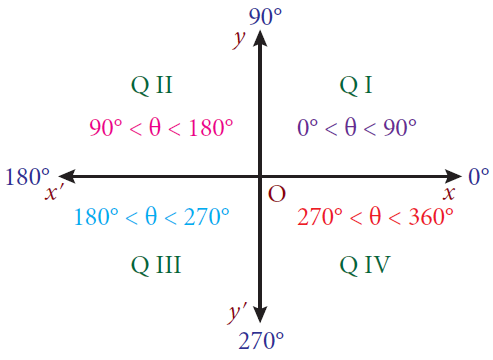HOW TO DETERMINE IN WHICH QUADRANT AN ANGLE LIES
An angle is said to be in standard position if its vertex is at the origin and its initial side is along the positive x-axis.
An angle is said to be in the first quadrant, if in the standard position, its terminal side falls in the first quadrant.
Similarly, we can define for the other three quadrants. Angles in standard position having their terminal sides along the x-axis or y-axis are called quadrantal angles.
Thus, 0°, 90°, 180°, 270° and 360° are quadrantal angles.

Counter Clockwise Rotation
One complete rotation of a ray in the anticlockwise direction results in an angle measuring of 360°.
By continuing the counter clockwise rotation, angles larger than 360◦ can be produced.
Clock Wise Rotation
If we rotate in clockwise direction, negative angles are produced.
Example :
Identify the quadrant in which each of the following angles lies.
(i) 25° (ii) 825° (iii) -55° (iv) 328° (v) -230°
Solution :
(i) 25°
Since 25° is between 0 and 90, it is in quadrant I.
(ii) 825°
825° is greater than 360°.
When 825° is divided by 360°, the remainder is 105°.
Since 105° is between 90° and 180°, it is in quadrant II.
That is, 825° is in quadrant II.
(iii) -55°
Since it is negative angle, we have to do counter clock rotation.
The difference between 360° and 55° is 305°.
Since 305° is between 270° and 360°, it is in quadrant IV.
So -55° is in quadrant IV.
(iv) 328°
Since 328° is between 270° and 360°, it is in quadrant IV.
(v) -230°
Since it is negative angle, we have to do counter clockwise rotation.
The difference between 360° and 230° is 130°.
Since 130° is between 90° and 180°, it is in quadrant II.
So -230° is in quadrant II.

Apart from the stuff given above, if you need any other stuff in math, please use our google custom search here.
Kindly mail your feedback to v4formath@gmail.com
We always appreciate your feedback.
©All rights reserved. onlinemath4all.com
Recent Articles
-
AP Calculus BC Problems with Solutions
Apr 26, 25 05:49 AM
AP Calculus BC Problems with Solutions -
Digital SAT Math Problems and Solutions (Part - 150)
Apr 25, 25 11:46 AM
Digital SAT Math Problems and Solutions (Part - 150) -
AP Calculus AB Problems with Solutions (Part - 19)
Apr 24, 25 11:10 PM
AP Calculus AB Problems with Solutions (Part - 19)